I *love* sparkling tea. By that, I mean Camellia sinensis prepared with seltzer. (Depending on where you live, you might call it carbonated water, soda water, or something else.) This post shares some tips for making sparkling tea at home. (This post was updated on 6/22/25.)
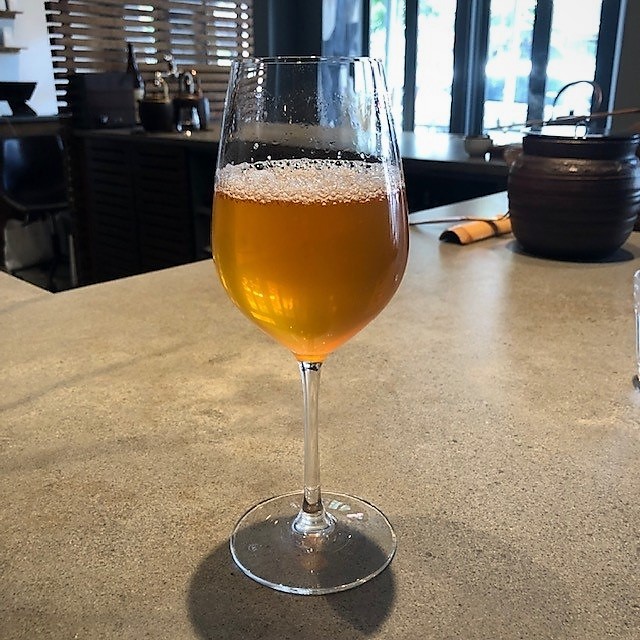
Sparkling tea was on my radar for a while. Alas, I didn’t encounter a place that served it until the summer of 2019, when I visited the 29B Teahouse on Manhattan’s Lower East Side. I ordered an excellent ceremonial grade matcha and a glass of sparkling Darjeeling tea, knowing that I could never drink that much caffeine at once. My plan was to drink about half of each. Reader: I drank every drop of both. It is probably the most tea drunk I have ever been. #NoRegrets
Sparkling Darjeeling was a revelation. It was incredibly floral with a rich tapestry of aromas and flavors. I couldn’t believe how delicious it was. I had previously assumed that I couldn’t make my own sparkling tea at home since I didn’t have a seltzer machine (AKA soda maker); however, that delicious glass of effervescent liquid sunshine made me determined to figure out how to do it. I tried two methods–one by making a concentrate, the other by cold brewing directly in the seltzer.
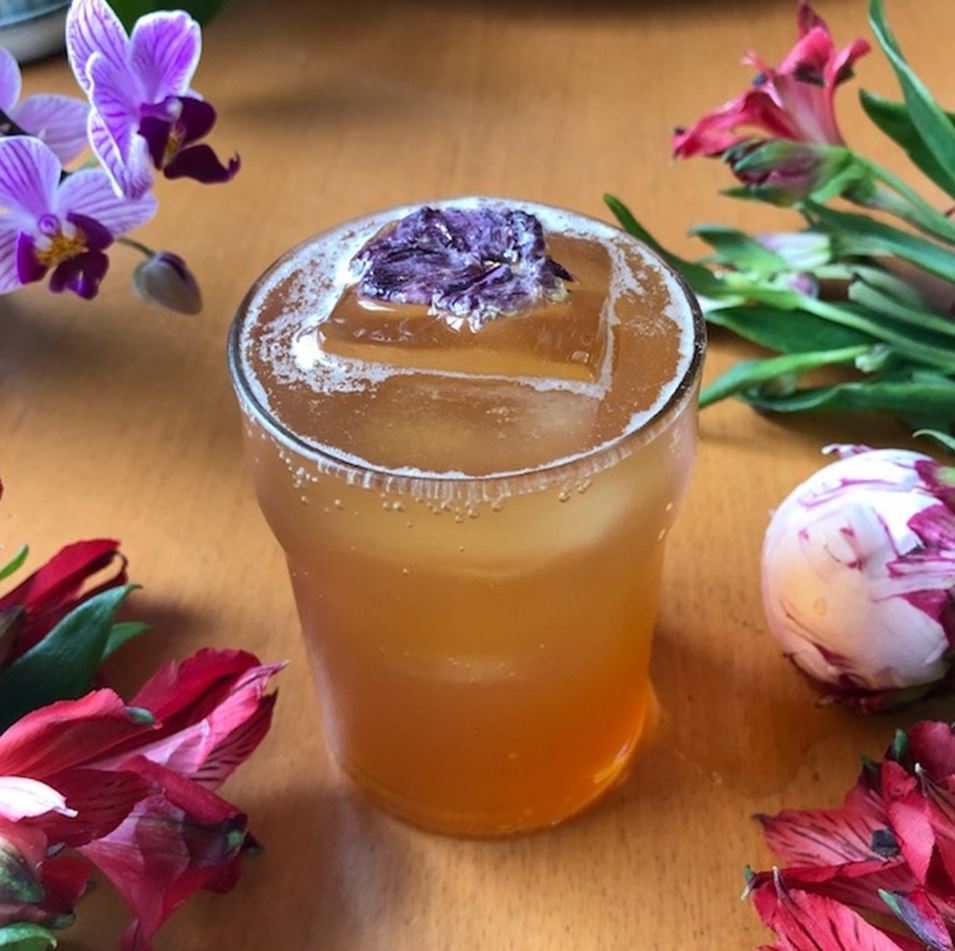
Concentrate Method
Concentrates can work beautifully if you don’t mind sacrificing some fizziness. I had very good results making sparkling tea with a strong concentrate of Darjeeling first and second flushes. It has also worked beautifully with other teas I tried. The key, for my taste buds, is a very high ratio of tea leaves to water, not a prolonged steep. (Since I am going to dilute the concentrate with seltzer, I make the concentrate four-to-five times stronger than how I prepare my cups of tea.) When combining the concentrate with the seltzer, I tend to use a ratio of about 1 part concentrate to 4 parts seltzer.
This method provides excellent flavor and can be made relatively quickly. The downside is it won’t be quite as bubbly when you add the concentrate. It also requires heat, which could be a downside on a hot summer day.
Pro Tip: Chill the concentrate and the seltzer before you combine them. Adding concentrate dilutes the carbonation in the seltzer. If you chill them both before combining, you can avoid further diluting the flavors and the fizziness with ice.

Cold Brewed Directly in Seltzer
Despite a summer of experiments making sparkling tea at home, my limited ability to consume caffeine means I haven’t done as nearly as many as I would like. Without a large number of trials, it’s a challenge to separate causation from correlation. That disclaimer aside, here are a few (tentative) observations–some that surprised me–that you may find helpful if you want to make a very fizzy sparkling tea by cold brewing it directly in seltzer.
IMPORTANT POINT COMPARING COLD BREW IN SELTZER TO REGULAR WATER
Tea steeps more slowly in cold seltzer than in cold water. So, the steep time in seltzer needs to be longer than for regular cold brewed tea. (Update 6/22/25, i.e., with much more experience. Here’s an exception: Some Japanese teas can cold brew in seltzer fairly quickly. For example, I have put a Yuzu Matcha Kukicha tea bag in a cup at a self-serve drinker counter, filled it with seltzer, waited 5 minutes, and gotten a delicious result.)
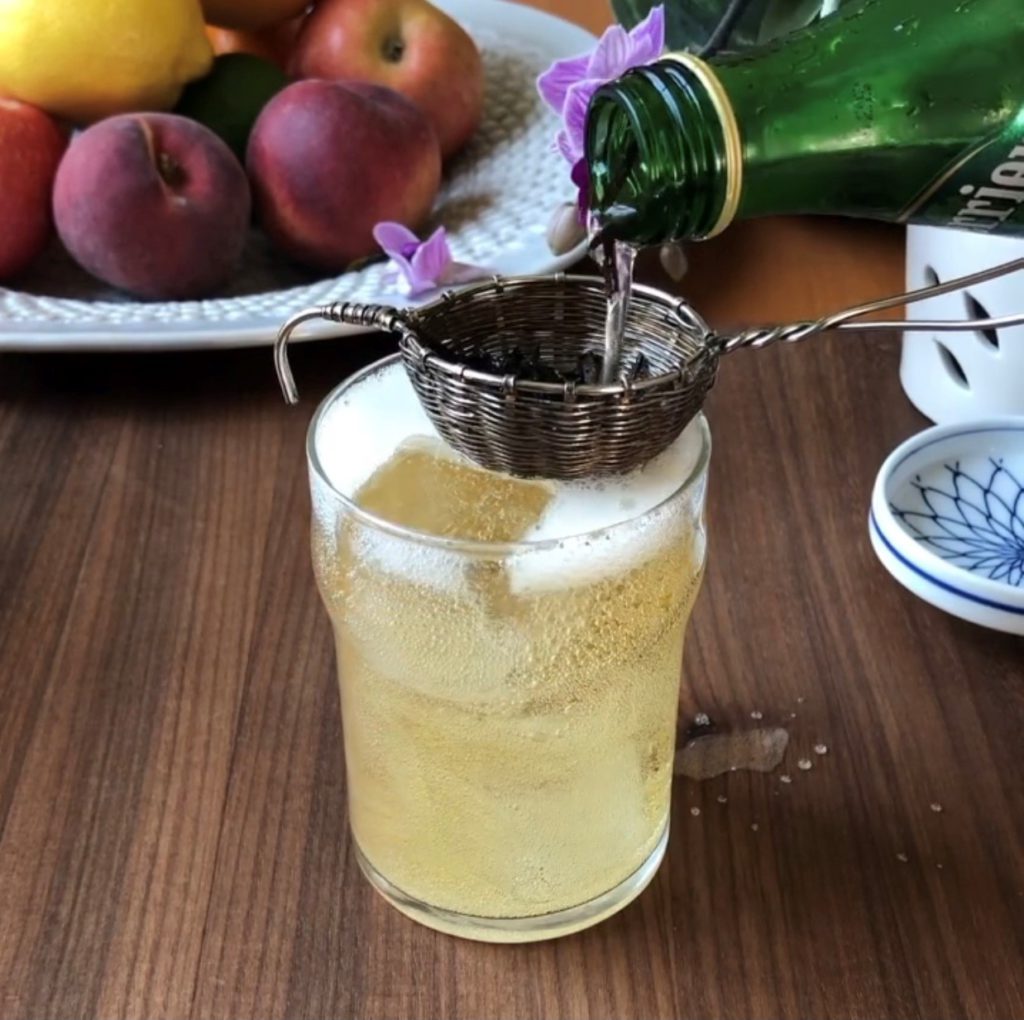
BRAND OF SELTZER
Something that I didn’t expect (even though I should have known better), was that the brand of seltzer would affect the results. I am not sure I would have thought of this if a talented Instagram photographer and tea friend, Nicole from @tea_on_the_trail, hadn’t decided to try making sparkling tea at home, too, and shared that she had really disappointing results with San Pellegrino. I tried using San Pellegrino and had similarly disappointing results. (By the way, that’s a seltzer that I enjoy drinking when I am dining out. So, no shade on them!) This means if at first you don’t like a tea when you cold-brew it in seltzer, you might want to try a different seltzer before you switch to the concentrate method or give up.
Bottom line on brand: I had the best (and very delicious) luck with Perrier in glass bottles.
SIZE OF SELTZER BOTTLE
Once I realized Perrier was the most convenient for me to buy and was giving me delicious results with my target tea this summer (Balhyo Cha), I compared using the single-serve approximately 11 and 25 ounce Perrier bottles (with proportionate amounts of tea leaves). The results were great with the 11 ounce and good with the 25 ounce. When steeped the same amount of time, the 11 ounce bottle kept noticeably more fizz in the sparkling tea. Perhaps the reduced carbonation is because it took longer to push over twice the quantity of tea leaves through a funnel into the 25 ounce bottle. I’m not sure. (Balhyo Cha, in case you aren’t familiar with it, is a Korean tea. I wrote a post that shares resources to learn more about Korean tea. You can find it here.)
Bottom line: I had the best results with a smaller bottle; however, the results with the larger bottle were still good.
(Update 6/22/25: If you find a tea that you enjoy cold brewing in seltzer and it’s rolled in balls (like some oolong) or bigger balls (say, like David’s tea Black Jasmine)…that can make it even easier to get into the seltzer bottle more efficiently.)
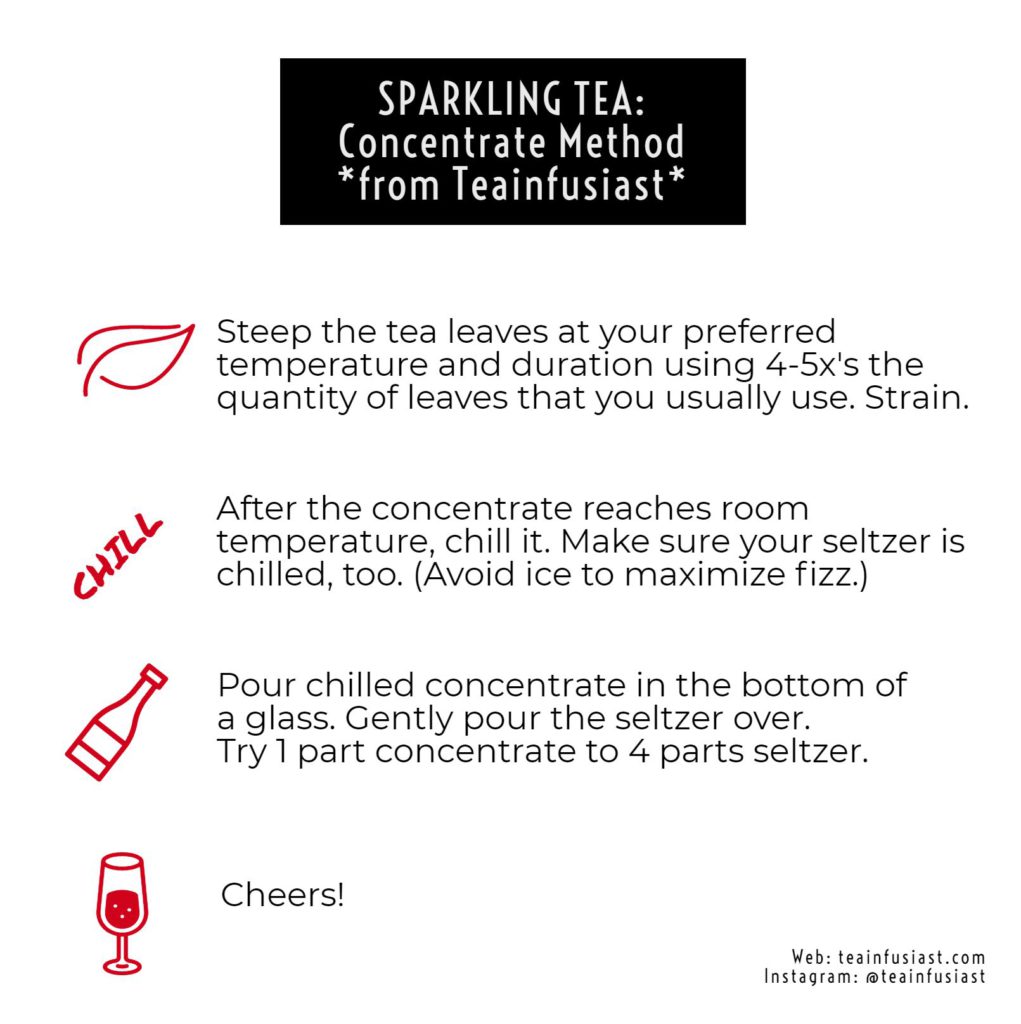

LENGTH OF STEEP AND QUANTITY OF TEA LEAVES
One challenge I wanted to figure out was the trade-off between longer steeps versus using quantity. I really wanted to figure out how to get a great flavor with fewer leaves. After all, using fewer tea leaves would keep the cost per serving of sparkling tea more economical.
In 11 oz glass Perrier glass bottles, I compared 2.5 tsp Balhyo Cha steeped for 44 hours (about two days) to 3.5 tsp Balhyo Cha steeped for 20 hours (about one day). They tasted very similar AND DELICIOUS–bursting with deep chocolate and creamy notes and naturally sweet without anything added. It was like a grown-up, ridiculously gourmet, chocolate soda. To discern whether there were any differences, I had to taste several times, clearing my palate in between. Although close, I’d say the 3.5 tsp Balhyo Cha with the shorter steep was slightly deeper in flavor. So, if you have time, and you don’t mind sacrificing a tiny bit of flavor, you can save tea and money by doing the longer steep with fewer leaves.
Bottom line: more tea leaves boost flavor slightly more than a longer steep (at least for the teas I tried). But, the difference was minor.
SOME TEAS CHANGED FLAVOR PROFILES WHEN COLD BREWED IN SELTZER
I love, love, love the Balhyo Cha cold brewed in seltzer and thought it was a delightfully fizzy version with a similar flavor profile as when I enjoy it hot, perhaps even deeper chocolate notes. But, it wasn’t so straight forward with every tea I tried. One green tea I cold brewed in seltzer that had floral notes when steeped hot, for example, turned more vegetal (but still good). I tried another tea that has a bit of smokiness when steeped hot that intensified the smokiness when cold steeped in the seltzer! I would not have predicted either of these changes! So, flavor outcomes can vary based on the chosen tea, the type of seltzer, etc.
Closing Thoughts on Sparkling Teas
Tea preferences are very personal. Luckily, tea is very customizable. These were my observations and preferences on ratios and brewing parameters for sparkling teas. But, you should feel free–encouraged even–to experiment and find what works best for you.
As for me, although the flavor results are more reliable with the concentrate method, I tend to gravitate toward fizzier seltzer and I really love the cold brew in seltzer method…when it works out. If you tend to prefer less bubbly seltzer, the concentrate method may be better for you. Either way, I’d love to know your favorite sparkling teas and methods! I encourage you to ask questions or share your experience in the comments.
Want More Tips?
If you are interested in more iced tea tips, check out my post 10 Iced Tea Hacks.
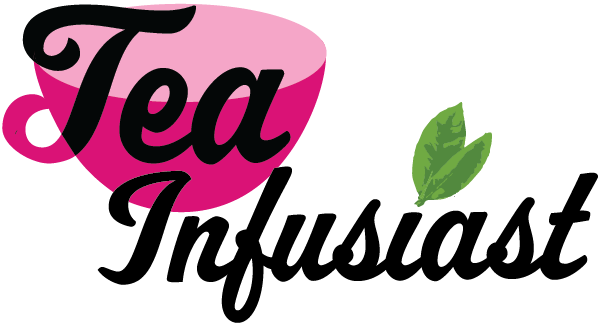
2 replies on “How to Make Sparkling Tea from Concentrate or Cold Brewed in Seltzer”
So grateful for this post! I came back to brush up on techniques, and realized I never properly thanked you for the shoutout! It’s so helpful swapping our tea-search notes, but even more wonderful that you’ve distilled them into such a useful guide. ( pun semi-intended 😉) I’ll be using this a lot during these dog days of summer!
Ahhh. Thanks for the kind words and for letting me know it was helpful, Nicole! 🙂 –Traci